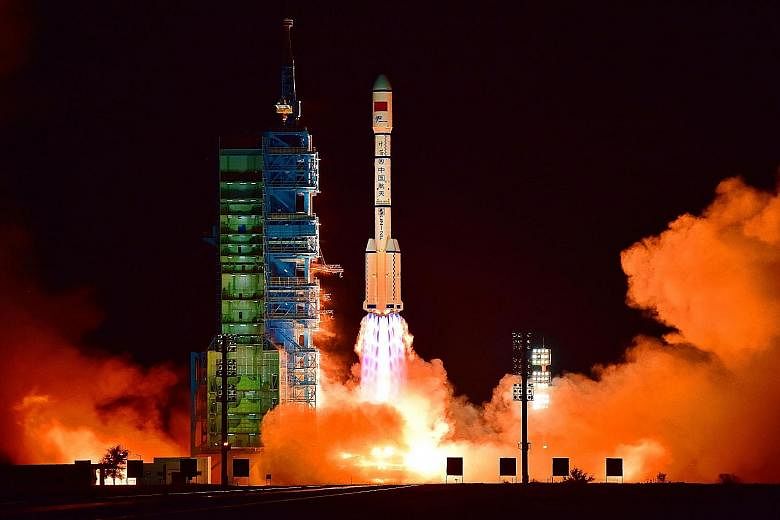BEIJING • China has launched its second experimental space laboratory, part of a broader plan to have a permanent manned space station in service around 2022.
Advancing China's space programme is a priority for Beijing, with President Xi Jinping calling for the country to establish itself as a space power, and apart from its civilian ambitions, Beijing has tested anti-satellite missiles.
China insists its space programme is for peaceful purposes, but the United States Defence Department has highlighted its increasing space capabilities, saying it was pursuing activities aimed to prevent adversaries from using space-based assets in a crisis.
In a manned space mission in 2013, three Chinese astronauts spent 15 days in orbit and docked with an experimental space laboratory, the Tiangong 1, or Heavenly Palace. Tiangong 1 ended transmissions in March this year. It is expected to fall back to Earth in the second half of next year.
Its successor, Tiangong 2, lifted off on a Long March rocket just after 10pm on Thursday from the remote launch site in Jiuquan, in the Gobi Desert, in images carried live on state television.
The Shenzhou 11 spacecraft, which will carry two astronauts and dock with Tiangong 2, will be launched some time next month.
The astronauts expect to remain in Tiangong 2 for about a month, testing systems and processes for mid-term stays in space and refuelling, and conduct medical and other experiments.
The smooth launch imparts a high-tech sheen to the week-long celebrations of China's National Day, starting on Oct 1, as well as this week's Mid-Autumn Festival holiday.
Mr Zhou Jianping, chief engineer of China's manned space programme, said Tiangong 2 also aimed to verify technology involved in the construction of the space station.
"It has the basic technological capacity of a space station. Once the space lab mission comes to an end, China will start building its own space station," he said, adding this could start as early as next year.
In April next year, China's first space cargo ship Tianzhou 1 will be sent towards the space lab, providing fuel and other supplies.
China is pouring billions into its space programme and working to catch up with the US and Europe. It hopes to have a crewed outpost by 2022. Beijing sees its military-run space programme as symbolising the country's progress and a marker of its rising global stature.
The nation's first lunar rover was launched in late 2013, and while it was beset by mechanical troubles, it far outlived its expected lifespan, finally shutting down only last month.
But for the most part, China has so far replicated activities that the US and Soviet Union pioneered decades ago. Its Jade Rabbit rover and the Chang'e 3 probe that carried it there were the first "soft landing" on the moon since 1976. Both the US and Soviet Union had accomplished the feat earlier.
China intends to eventually put one of its citizens on the surface of the moon. It announced in April it aims to send a spacecraft "around 2020" to orbit Mars, land and deploy a rover to explore the surface.
REUTERS, AGENCE FRANCE-PRESSE

